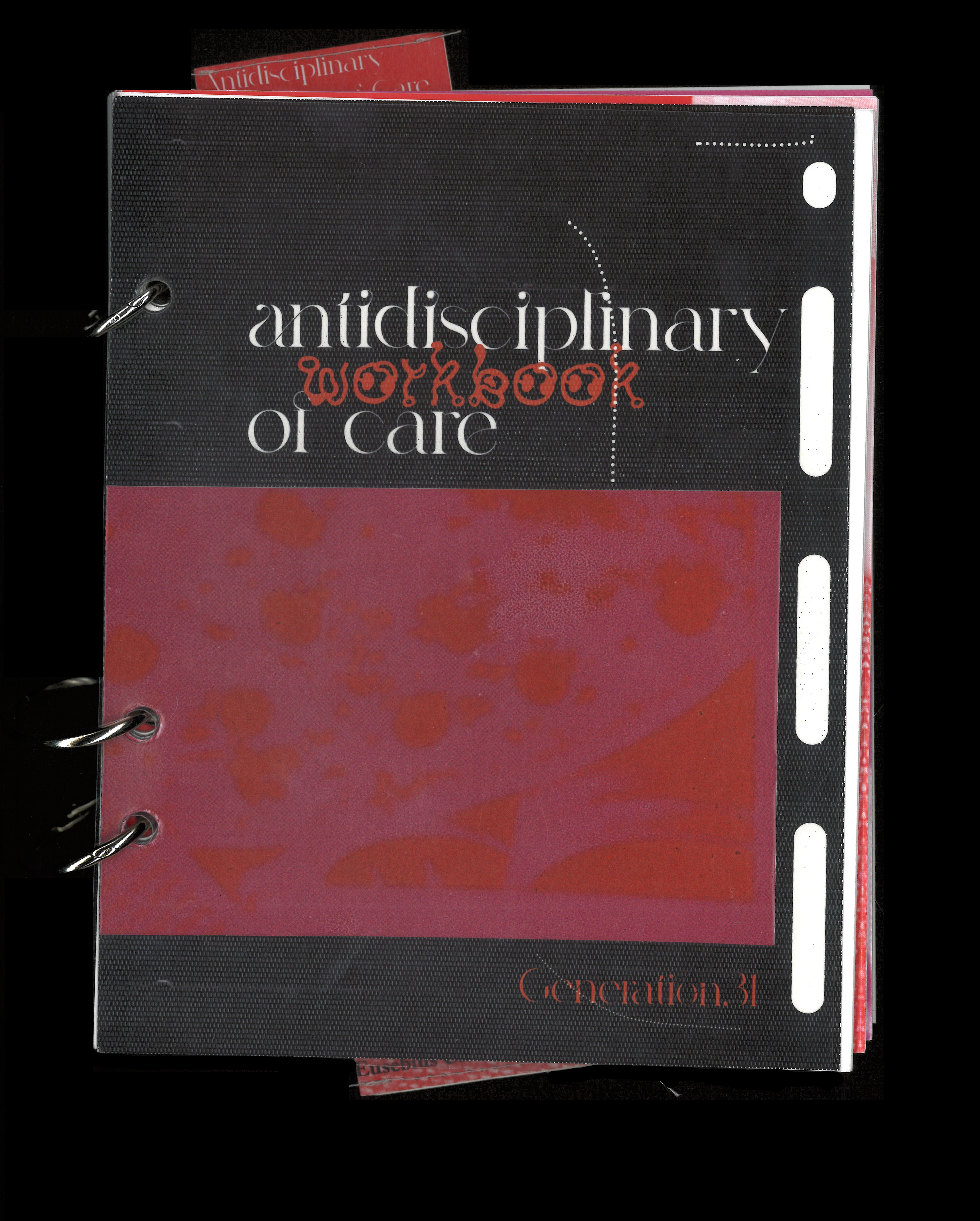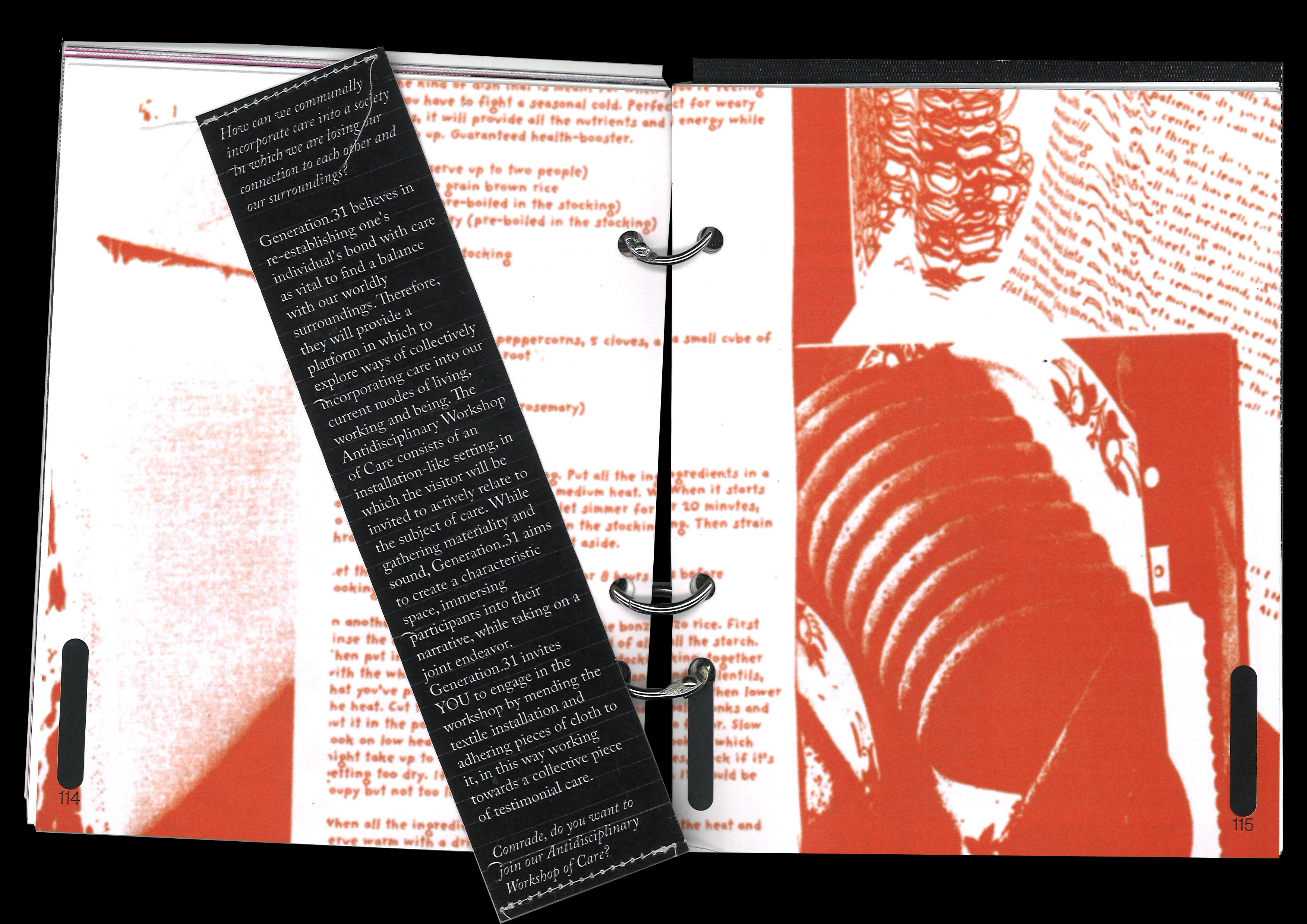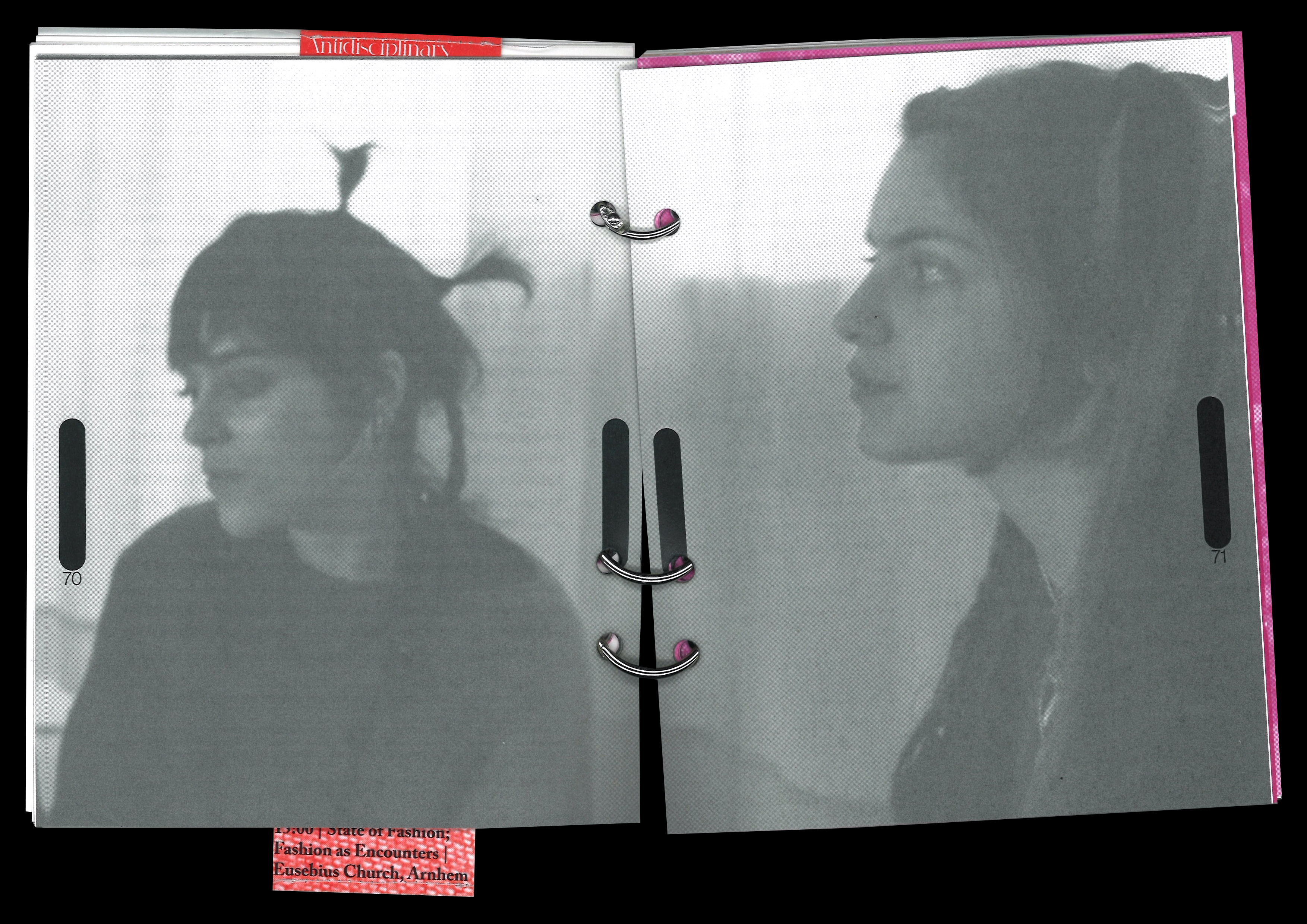(2022)
Text - (Self-) Publishing
Text - (Self-) Publishing
antidisciplinary workbook of care

Antidisciplinary Workbook of Care - Manifesto
Written in collaboration with Leah Gaynor & Malú van der Bijl
Carelessness has ascended to the throne and has been reigning supreme within the dominant realities of western society, influencing our ways of living and being. We live in a society where the creation of capital has become the divine being we devote our lives to; resulting in the given that we are losing our connection to care. Within this model, we are exploiting care as a means to create exchange value; emphasizing the individual benefit and neglecting the communal experience. Re-establishing this bond is vital to find a balance with the world surrounding us. As a collective, we are not satisfied with the position care holds within our society. We have decided not to stand by idly whilst care is commodified and pushed to the side-lines. We have created the Antidisciplinary Workbook of Care to elaborate on the subject of care, caring and taking care in more organic, shared, communal and non-commodified manners.
Care is about sharing the knowledge of the (im)material body; its rituals, its recovery, its intimacy, its connection, its solidarity. To suggest a solitary form of care is to imply the communal aspect of caring. It is about living together, connecting together, sticking together and dying together. Care then becomes a way of shared living, shared sharing and shared caring. It is about supporting one's comrades, supporting the objects around us and supporting the power of knowledge.
The workbook encompasses several examples and exercises in which to activate these forms of care. There are two aspects in which this workbook focuses on: community and knowledge and its relation to care. Care in relation to community means taking care of marginalized groups and bringing individuals and voices together. Care in relation to knowledge means to see caring as an act of sharing knowledge and creating learning communities.
These aspects of caring get back to the root of care that are a great deal of a time lost in a modern, neo-liberal system. So therefore;
We care for crafts, handiwork and sharing these skills. We reclaim power by being able to make our own creations. It gives us tools to exist out of the system and thus, the conventional reality, where carelessness reigns. Therefore we use sharing knowledge and skills about handmaking to strengthen the relationships with not only each other, but also our material artifacts
We care about sharing our areas of expertise in our everyday lives. The diversity of our cultural and educational background is what makes us a heterogeneous and multiform community. Therefore we care about teaching, learning, and sharing our strengths with each other to enrich our lives.
We care about listening and giving voice to subculture communities. These groups differentiate from the dominant culture they belong to, because of this they unite and support each other within their community. Therefore we approach them to understand the sense of communal care through their lived experiences and stories.
We care for community, kinship and familiar bonds. The [queer] body is never alone, it is dependent on support, solidarity and gossip. Therefore we care for our comrades as a commitment to a line of deviation.
We care for our bond with the material world. In exploring our relationship with material we question the ways of western society and explore how the objects that surround us can become carriers of stories and meaning. Therefore we are able to connect with each other through the objects we share.
We care for nurturing our relationships through activation. We are concerned with instilling feelings of love and connection into our relationships. Therefore, we activate our care for our loved ones in order to enrich our relationships with these individuals.
We care for words, sayings and stories told by our beloved ones. We linger on what is usually bound to be handed down by voices, and we engrave it onto surfaces conferring it eternal life. Therefore we care for the small gestures that give beauty to life, for what gives us safety, love and the feeling of belonging and companionship, even in solitude.
We care about sharing our areas of expertise in our everyday lives. The diversity of our cultural and educational background is what makes us a heterogeneous and multiform community. Therefore we care about teaching, learning, and sharing our strengths with each other to enrich our lives.
We care about listening and giving voice to subculture communities. These groups differentiate from the dominant culture they belong to, because of this they unite and support each other within their community. Therefore we approach them to understand the sense of communal care through their lived experiences and stories.
We care for community, kinship and familiar bonds. The [queer] body is never alone, it is dependent on support, solidarity and gossip. Therefore we care for our comrades as a commitment to a line of deviation.
We care for our bond with the material world. In exploring our relationship with material we question the ways of western society and explore how the objects that surround us can become carriers of stories and meaning. Therefore we are able to connect with each other through the objects we share.
We care for nurturing our relationships through activation. We are concerned with instilling feelings of love and connection into our relationships. Therefore, we activate our care for our loved ones in order to enrich our relationships with these individuals.
We care for words, sayings and stories told by our beloved ones. We linger on what is usually bound to be handed down by voices, and we engrave it onto surfaces conferring it eternal life. Therefore we care for the small gestures that give beauty to life, for what gives us safety, love and the feeling of belonging and companionship, even in solitude.
The Antidisciplinary Workbook of Care takes the shape of a community experience archive. The ways in which we take care, should suggest the ways in which you, our future caretaker, could take care. The addition of uninhabited pages is an invitation to participate within our ongoing activities of taking care. We invite you to inhabit them via documenting your reproductive experience of the suggested activities as well as adding your personal activities of [taking] care.
To [take] care in such a manner advocates ways of learning to touch, feel, read, feed, share and learn in a collective manner of caring. The caretaker then takes the shape of a protagonist who travels between a multitude of different outside realities while carrying items of trade; shared knowledge, insight, methods, gossips, shoulders to cry on, networks of kinship, remedies and crafts .


Contribution
queer braiding circle
Within this Queer Braiding Circle we share food, drink wine and share stories. We venture and explore stories of being queer. We gossip about the ‘given’ and we care for our comrades' hair. While participating in such a practice, a broad spectrum of bodies queers themselves towards a ‘queer’ community, kinship and a familiar bond.
Suddenly, a rhythm started to dance. The quiet atmosphere that used to surround us fades away into heartfelt whispers. Their tone is incriminating though — our ears are likely on fire, our voices are positively rumbling and our hands are dancing to their drum — it grabs my attention, focusing more on the hair I am braiding. We huddle around each other, leaning towards our comrades, whispering, peeking around to see if anyone’s listening. No one is. At this moment we are utterly alone, alone with our comrades. Fueling a fire of deviation. We danced, we shared, we loved and we braided.
Tjerre Lucas Bijker’s contribution of the “Queer Braiding Circle” was later on also published in BRAIDS (Janaury 2023)




























